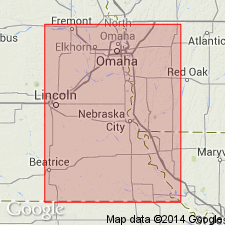
- Usage in publication:
-
- Turner Creek shale bed
- Modifications:
-
- Original reference
- Dominant lithology:
-
- Shale
- AAPG geologic province:
-
- Forest City basin
Summary:
Pg. 42, 52, 53. Turner Creek shale bed of Topeka limestone member of Shawnee formation. Bluish-gray calcareous shale. Thickness 5 feet in southwestern Iowa, 3 feet-9 inches in southeastern Nebraska, 4.5 feet in northeastern Kansas, 5+ feet in northwestern Missouri. Overlies Curzen [Curzon] limestone and underlies Du Bois limestone. Age is Late Pennsylvanian (Missouri age). Report includes cross sections, measured sections, geologic maps, stratigraphic tables.
Named from Turner Creek exposures southeast of Du Bois, NE.
[This is definition followed by R.C. Moore and G.E. Condra in their Oct. 1932 revised classification chart of Pennsylvanian rocks of Kansas and Nebraska. G.E. Condra, 1935 (Nebraska Geol. Survey Paper, no. 8), discarded Curzon limestone for Hartford limestone, the older name. For Condra's latest interpretation of stratigraphic position of this shale see 1937 entry under Topeka limestone.]
Source: US geologic names lexicon (USGS Bull. 896, p. 2199); GNC KS-NE Pennsylvanian Corr. Chart, sheet 1, Oct. 1936; supplemental information from GNU records (USGS DDS-6; Denver GNULEX).
For more information, please contact Nancy Stamm, Geologic Names Committee Secretary.
Asterisk (*) indicates published by U.S. Geological Survey authors.
"No current usage" (†) implies that a name has been abandoned or has fallen into disuse. Former usage and, if known, replacement name given in parentheses ( ).
Slash (/) indicates name conflicts with nomenclatural guidelines (CSN, 1933; ACSN, 1961, 1970; NACSN, 1983, 2005, 2021). May be explained within brackets ([ ]).

